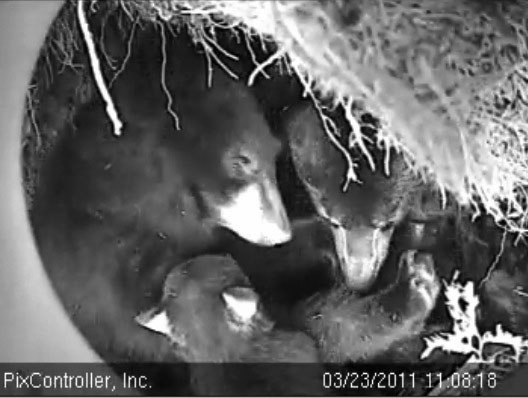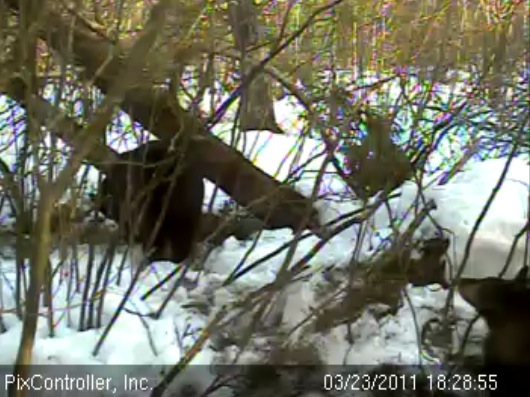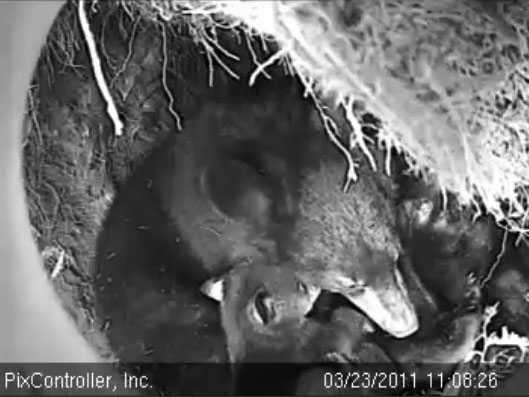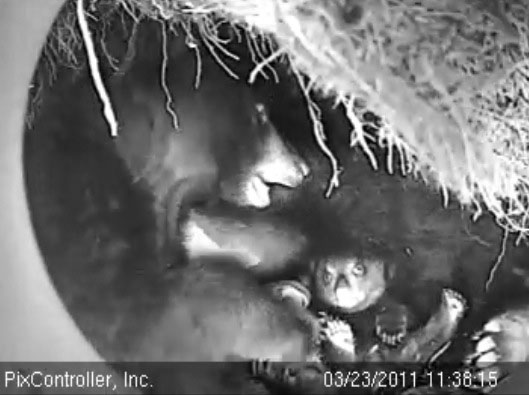Energy Abounds
 No one would have guessed how much energy wild bears would burn up playing in a den when they’ve hardly eaten for 5 months. What will Lily and Hope’s weight losses be? Is Hope’s amazing desire to play fueled by Lily’s milk? Maybe we’ll see a whole different Hope next winter when she dens with Faith, Jason and a non-lactating Lily. We’ll probably see a lot more sleeping then, but we would have predicted less activity this winter, too. We’re all learning together. The Den-watch team is recording activities to create a daily activity budget for each of the bears for comparison with last year and next year.
No one would have guessed how much energy wild bears would burn up playing in a den when they’ve hardly eaten for 5 months. What will Lily and Hope’s weight losses be? Is Hope’s amazing desire to play fueled by Lily’s milk? Maybe we’ll see a whole different Hope next winter when she dens with Faith, Jason and a non-lactating Lily. We’ll probably see a lot more sleeping then, but we would have predicted less activity this winter, too. We’re all learning together. The Den-watch team is recording activities to create a daily activity budget for each of the bears for comparison with last year and next year.
Buffeted by all the play between Lily and Hope, the cubs keep right on nursing best they can and they’re growing. When they’re not nursing, they’re being manipulated by Lily and especially Hope, but they usually don’t squawk, so it’s fine. Hope will get her comeuppance when these cubs are bigger and gang up on her! We suspect she will love it though. When we accompany them this summer, we can compare the cubs growth and personalities to other cubs we’ve known. We’ll see if they more readily accept touching and radio-collaring or are more averse to it.

Lily is raking in more bedding from the surface of the snow—mostly from under the fallen cedars that made their den. When the cedars fell, their roots pulled up a mass of soil and vegetation to make the roof. Earlier today she dragged a rotten log over to the den and chewed that up for bedding as well. In the den, she and Hope have been busy chewing up the branches and dead wood to add to the bed. Looks pretty lumpy to us, and watching the cubs attempt to navigate the new bedding is a hoot!
Sometimes when Lily was outside today she was attentive to something in the distance. As we snowmobiled in yesterday we noticed deer tracks everywhere and fresh moose tracks and droppings about 1.25 miles from the den. She seemed attentive and interested but not alarmed by whatever she was seeing or hearing, so no worries.
Yesterday’s update was about theories that we don’t believe were factors in Lily leaving Hope. It’s possible that Hope could still show some abnormality, but she appears healthy. The longer we know her the more certain about that we can be. Little Knut, the polar bear that was rejected by his mother as a cub, didn’t have anything show up until he was 4 years old. Did that have anything to do with him being abandoned in captivity? We’ll never know.
 Now, for completion, we should re-cover old ground about why we think Lily twice left Hope—for 5 days and then for nearly 6 weeks. In short, hormones. Basically, we think little Hope couldn’t nurse enough to stimulate the full production of the hormone prolactin needed to inhibit Lily’s production of follicle-stimulating hormone (FSH) and luteinizing hormone (LH). The result was maturation of follicles and Lily coming into estrus. It’s true that the first separation involved Lily intensely sniffing fresh tracks, probably from a male, and heading off. Once gone, she didn’t have the drive to return for days. She was busy sniffing branches, the ground, tree trunks, and bear trails for any scent of bears. In retrospect, she was showing behavior we see in estrous females. Then, the joyous, playful reunion with several days of nursing. It probably was largely ineffective nursing, though, considering Lily’s lumpy breasts, indicating clogged milk ducts. Even reunited with Hope, Lily also showed marking behavior consistent with estrous females. Then came the meeting with Lily’s mother June. June was making friendly sounds, which was a surprise to us, but Lily retreated anyway and showed no inclination to return. She was off mating. After six weeks, Lily and Hope re-united and Lily was the normal protective, playful, nursing mother that we are witnessing every day.
Now, for completion, we should re-cover old ground about why we think Lily twice left Hope—for 5 days and then for nearly 6 weeks. In short, hormones. Basically, we think little Hope couldn’t nurse enough to stimulate the full production of the hormone prolactin needed to inhibit Lily’s production of follicle-stimulating hormone (FSH) and luteinizing hormone (LH). The result was maturation of follicles and Lily coming into estrus. It’s true that the first separation involved Lily intensely sniffing fresh tracks, probably from a male, and heading off. Once gone, she didn’t have the drive to return for days. She was busy sniffing branches, the ground, tree trunks, and bear trails for any scent of bears. In retrospect, she was showing behavior we see in estrous females. Then, the joyous, playful reunion with several days of nursing. It probably was largely ineffective nursing, though, considering Lily’s lumpy breasts, indicating clogged milk ducts. Even reunited with Hope, Lily also showed marking behavior consistent with estrous females. Then came the meeting with Lily’s mother June. June was making friendly sounds, which was a surprise to us, but Lily retreated anyway and showed no inclination to return. She was off mating. After six weeks, Lily and Hope re-united and Lily was the normal protective, playful, nursing mother that we are witnessing every day.
 We think it was all about hormones and none of that other stuff we mentioned yesterday. Lily has six nipples, and Hope mostly used only the two anterior ones. It wasn’t enough to keep Lily going. For some mothers, one cub is enough. That’s probably a case of individual variability. Think of the bell-shaped curve. For just about anything biological that we could talk about, most are near the middle of the curve and a few are out in the tails. For one of the peer-reviewed papers we are writing, we are looking at cub survival relative to litter size. We’re thinking that very large litters run a risk of starvation, especially in bad food years. But we’re thinking that for litters of one, risks include abandonment due to inadequate production of prolactin. That’s probably why most litters are two or three. Those are the litter sizes with the greatest number of cubs surviving to the next generation, on the average.
We think it was all about hormones and none of that other stuff we mentioned yesterday. Lily has six nipples, and Hope mostly used only the two anterior ones. It wasn’t enough to keep Lily going. For some mothers, one cub is enough. That’s probably a case of individual variability. Think of the bell-shaped curve. For just about anything biological that we could talk about, most are near the middle of the curve and a few are out in the tails. For one of the peer-reviewed papers we are writing, we are looking at cub survival relative to litter size. We’re thinking that very large litters run a risk of starvation, especially in bad food years. But we’re thinking that for litters of one, risks include abandonment due to inadequate production of prolactin. That’s probably why most litters are two or three. Those are the litter sizes with the greatest number of cubs surviving to the next generation, on the average.
You came up with more votes than ever, nearly 13,000, to put Ely back in 6th place after slipping to 7th last night in the stiff competition. For perspective, Ely has 3 times as many votes as similar-sized Park Rapids, Minnesota, showing what you have done. The site for casting 10 votes a day is http://wehearyouamerica.readersdigest.com/town.jsp?town=ELY&state=MN.
Please check for recent ‘bearstudy’ video uploads at http://www.youtube.com/user/bearstudy#g/u.
Thank you for all you are doing.
Lynn Rogers and Sue Mansfield, Biologists, Wildlife Research Institute and North American Bear Center
